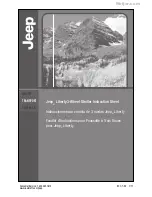
AFMNA0AA – EPS-BLI HYG – User Manual
Page – 53/75
- Remedy:
If it is repetitive, it is necessary to replace the controller
10) LOGIC FAILURE #3
Alarm 0xFF11 = 17 Group #0 [M,S]:
-
Cause: This alarm occurs in the rest state if the output of the voltage
amplifier on the phase-to-phase voltage Vv-Vu has a drift larger
than ±0.25 V with respect to the rest value it had at key-on.
-
Remedy: It is necessary to replace the controller.
11) HIGH CURRENT
Alarm 0xFF46 = 70 Group #0 [M,S]:
- Cause:
This alarm occurs in case at key-on the circuit for limiting the
maximum current via hardware is always active (it can be due to a
failure of a current amplifier).
- Remedy:
If it is repetitive, it is necessary to replace the controller.
12) STBY I HIGH
Alarm 0xFF35 = 53 Group #0 [M,S]:
- Cause:
This alarm occurs when the E-steering motor controller is at rest,
in case at least one current amplifiers on phases U and W is not in
a narrow window of ± 300 mV around 2.5 V 10 ms long (sampling
time 2 ms for 5 consecutive samples). Admitted output at rest is
2.2 V through 2.8 V.
- Remedy:
If it is repetitive, it is necessary to replace the controller
13) HIGH TEMPERATURE
Alarm 0xFF3D = 61 Group #3 [M,S]:
- Cause:
This alarm occurs when the temperature in the power stage is
higher than 90 °C.
- Remedy:
Improve the cooling of the controller; otherwise it is necessary to
replace the controller.
14) EEPROM KO
Alarm 0xFF0D = 13 Group #0 [M,S]:
- Cause:
Every microcontroller has its own EEPROM with two parameters
lists (to have a local backup copy). Each list has its own
checksum. When both checksums are wrong, this alarm occurs. In
case a parameter list has a wrong checksum it will be repaired
using the second list (backup copy with a correct checksum).
- Remedy:
Perform CLEAR EEPROM. If the problem persists, replace
controller.
15) PARAM TRANSFER
Alarm 0xFFF4 = 244 Group #0 [M,S]:
- Cause:
Master uC and Slave uC have their own parameter lists (with their
local backup copies). Change of a parameter is handled by the
MuC only. MuC writes its own parameter and commands the SuC
to do the same on its own parameter list. Execution of the write
command in the SuC is protected by a password. This alarm is
















































